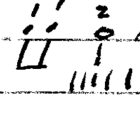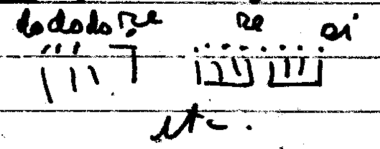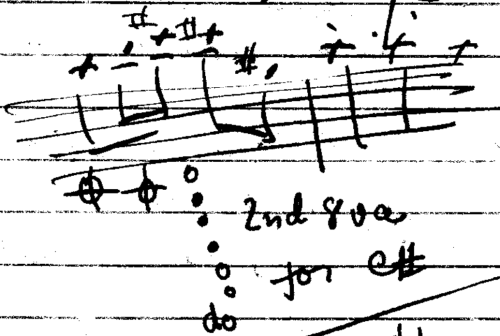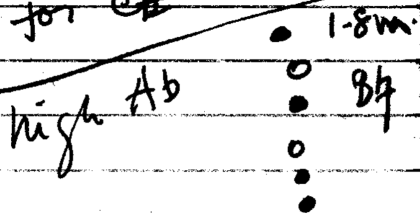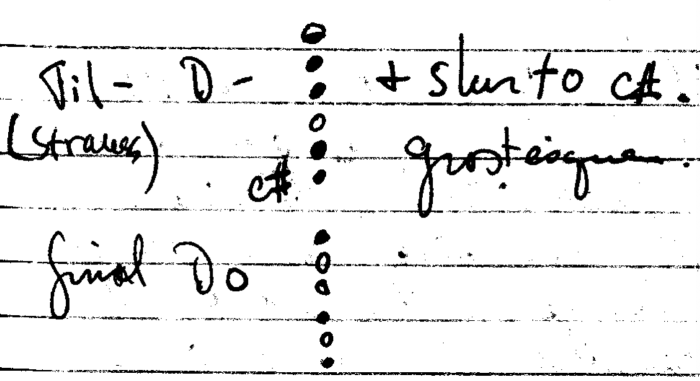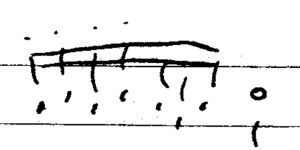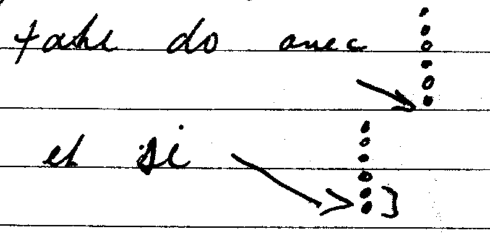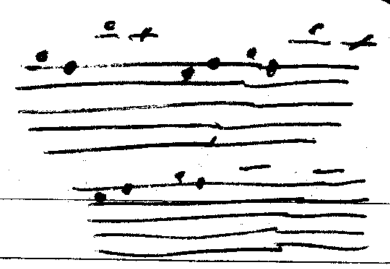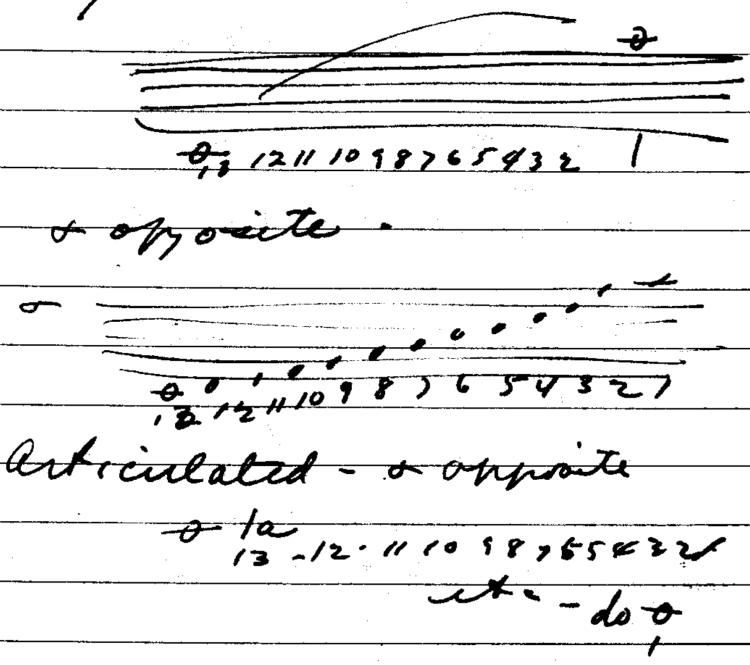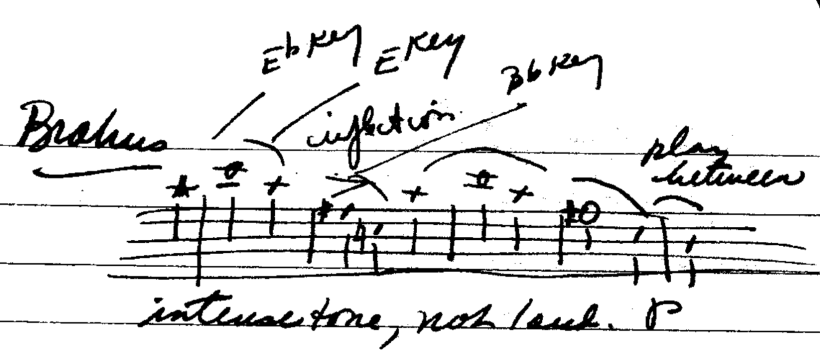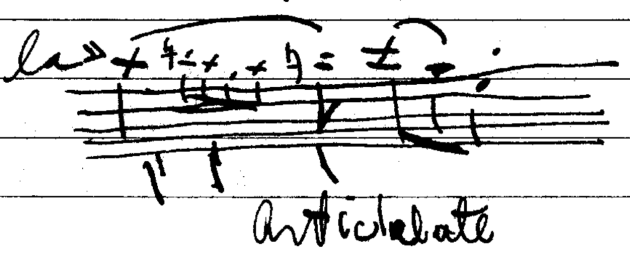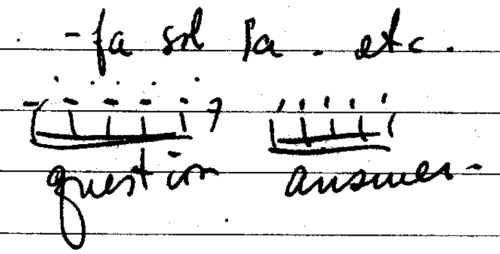Laila’s Private Lessons with Tabuteau 1948
Ludlow Building Studio
The Kansas City Symphony 1947-48 season ended early, so without work, Laila returned to Philadelphia in the Spring of 1948 to continue private lessons with Tabuteau. Laila now appears to be preparing for the Houston Symphony Orchestra where she will become the principal oboist.
Lesson 1: March 13, 1948
Practice Gillet Studies adagio. Take time between the intervals. That is the only way that these studies will do you any good. Make them sound as if they were beautiful music. Work them up to speed afterwards, but practice them slowly.
Mozart Oboe Quartet:
1st Movement:
Measure 1: Play the 8th-note subdivision in the F.
Measures 1 & 2: play the 8th notes 1-1-2, 2-2-3.
Measures 2-3: More on the D and heavy on the C; take time between the two Gs.
Measure 4: subdivide the G.
Measures 8-9 & 9-10: Play all of the 8th note subdivisions in the half notes.
Measures 13 & 14: On high C♯ and B: Sing and travel, do not bite.
Measures 17-18: Play the run lightly and finish on C: 1-1-2.
Measure 19-20: Play 1-2-2-3-3, then play two trills on 3 resolve and finish.
Measures 21-22: 1-1-2-2-3-4, trilling on 3.
Measures 23-24: 2-2-3-3-4-5.
Measure 25: 4-4-5-6.
Measure 26: Place the weight on the F♯ then play all three Gs staccato.
Measure 31: Place the weight on the high C.
Measure 33: Practice the first note of each quadruplet: C♯-E-G♯-B natural; then practice every two notes.
Measure 34: 1-1-2-3-4-4-3-2 |1 and play heavy on the D before the final B.
Measure 40: Practice the following: G-F♯-G-B natural-A with no jerk on the B; play this softly.
Measures 45-46: Play this with humor.
Measure 54: Don’t pronounce F♯-G.
Measures 68 & 69: Slur these groups. How you articulate is not the most important aspect. It must sound the same anyway you decide to do it.
Measures 82-83: The most difficult part of this movement is this run from D to D.
Measures 83-85: The high Ds are not so important but the moving notes E-F♯-G-A-B♭ are.
Measures 115 & 117: Don’t pronounce the F or G.
Measures 140-142: Subdivide the high C on 5 then comes the triplet 5-4-3 followed by| 2-2-1.
Measure 143: Take time before the final F.
3rd Movement Rondo:
Practice the skeleton form many times before doing the coloratura. It must travel more; the tone stays where it is, but it must always move. Sing!
Lesson 2: March 20, 1948
Take all the vibration out of the reed here:
Take a few scrapes in the middle and leave some on the sides to balance. Don’t take too much from the sides. After taking wood from the back, make the tip really thin. Scrape back and then cut the tip. The reed must be balanced correctly, then the notes will be there. Fix the reed so you can push the air through it.
You must travel the air. Practice exercises on 1-9-1, you must get range.
Barrel Grand Study 16: All detached and long. A big tone is a soft-small tone increased.
Practice two hours a day on range. You must have something to place a little phrase upon.
Lesson 3: March 27, 1948
Play more on the tip of the reed and with the air pressure. Use the nose-valve and let air out when holding a long note piano.
You must learn to play one note on the continuity of the last one. For high notes don’t force, play piano; and then the tone will gradually increase by itself.
Play 1-5-3-1 on one note. Attack. You must travel immediately.
Lesson 4: March 31, 1948
Some notes are like the flower, others are the fragrance. The steam and the vapor.
Practice little exercises as if one note is beautiful music. Everything must be scaled. Play free; don’t choke the tone. Play on the circle curve. Let a note be desired, don’t just give it away. Make it be asked for and play the beauty of it.
After 30 years, not a day passes when I don’t think 50 day times of what my teacher [Georges Gillet] told me. Only now do I really profit from what he advised: get a little rubber ball. Music to be phrased must respond to the fundamental laws of nature, scaled and rebounded less and less.
You must be open to everything. Learn from everything. The more you take from the world, the more you can give to the world (and do more than just shroom, scratching out reeds 10 hours a day) to develop your personality.
Lesson 5: April 7, 1948
Don’t pinch. You must blow more to make up for choking. Play freely and get the line.
Make all your exercises with intervals and play them as if there is only one step between them. Play broken arpeggios in all keys.
Practice on one note with the wind and with the embouchure squeezing in and out. Use air speed and free up your embouchure. Tighten your embouchure and use less wind. You must do it slowly between notes. Practice and it will come. Then your reeds will improve to take the demands of what you want to do.
Take one note and then play a whole scale on the same wind. Once you have it, it will be like second nature, or like swimming. You won’t forget, but you must have reeds to take it.
Push forward and get the technique of blowing. Play piano and take a note and swell it and see what you can do.
English horn fingerings:
When fingered B sinks or you wish to diminuendo, add fingers 2 and 3 in the right hand:
With C (producing F) use the fork in the right hand.
With G (producing C) add the low C key.
With high E and G, use the low B key.
Blow so you don’t play so sharp.
Lesson 7: April 14, 1948
Your lips must be like scissors for high notes, the lips of your embouchure over and under. Move your lower jaw a little forward with the upper teeth over forming a clamp. Then blow over the reed. Press with the left hand for pitch and intensity. Your lever must also be tight in the right spot for high notes. Do this to get ring and don’t play it flat.
Mozart Concertante: Pattern: 1-2-2-3, 1-2-2-3 to be practiced on one note with correct inflections. Some notes are long, some are short. Resolve on the 3. Sing! The last group can be: 1-2-2-1. Don’t pinch! Blow but not directly into the reed.
Barret Grand Study 3: Practice the trills in this study in all keys.
Try to find the Antoine Hugot Studies.
Get cadenzas ready to sound, always as if you have something to play. A little flare is necessary.
Never play before you think about what you are going to play, because this is like having a pen and not knowing what to write. First, you must have the idea of how you want it to sound in your head. Think!
Works played today for Tabuteau:
Beethoven Trio
Mozart Concertante
Paladihle Solo: Just the opening was played.
Don Quixote
Practice glissando or very slowly between 10ths etc.
Lesson 8: April 21, 1948
Fingerings to keep from being too sharp and allowing you to blow:
High A: use the F key
High B: use the F key
High C: use the C key
Always take middle E with the low B♭ key.
Practice Perfect 5ths and 12ths as if there is one note between them on one line. Evenness of tone on the upper notes is done only by embouchure position. Take care with the tone quality of the upper register: the position of the embouchure does it.
Since Laila will soon be heading to Houston, where she has been appointed principal oboe of the Houston Symphony Orchestra, Tabuteau concentrates on teaching to her his interpretations of the principal orchestral oboe solos. Laila is in a rush, taking a lesson practically every other day.
Lesson 9: September 14, 1948
Schubert Symphony 9, 2nd Movement: Practice Barret Progressive Melody 25 with its dotted rhythms. Play long on the dancing dotted 16th.
Measure 1 of the solo: Take the grace note re with the trill key.
Measure 6: Si-re-do-si-si etc: shorten the 32nds putting the weight on the dotted 16th si. Increase and then diminuendo. Don’t collapse on the do’s; practice as follows:
Measure 8: Play all E’s with the B key.
Measure 21: Use harmonic fingerings on A and B.
Tchaikovsky Violin Concerto: 1-1-2-3-4-5 and wait before the appoggiatura.
Strauss: Till Eulenspiegel as grotesque as is possible.
Try to develop your range for everything. Practice taking a breath on the fly: play four measures and then breathe after a change of note.
Lesson 10: September 16, 1948
Sellner Duo 4
Practice the following: 1-2-3-4-5-4-3-2-1 on one note detached. Then in perfect 5ths: la-mi-si = A-E-B-E-A slurred. Then when you have a little solo, you have something to play on.
Exaggerate, but in the right direction: always let the music determine the numbers and try to come as close as possible to what fits. You and the music are the best. Don’t force the pattern on the music.
If reeds play low C♯ to F♯ to E in the second register, they are not false.
You must practice. Emphasize resolutions.
Lesson 11: September 17, 1948
Play robust always. Blow and make the reeds to take it.
Saint-Saens Samson and Delila, Bacchanal: Use this solo for range and keep the same clear sound throughout. Blow straight and keep the same wind.
Rimsky-Korsakov Scheherazade: more oriental and slow between F♯ and G at the end of the run.
Strauss Don Quixote: Take high B♭ and A as harmonics, like a head tone.
Practice high notes like C♯ with range: 1-2-3-4-5-4-3-2-1.
Ravel Daphnis et Chloe: Paix, prendre le C♯ in Daphnis sur 5.
Lesson 12: September 18, 1948
Beethoven Trio 4th Movement: Practice the triplets.
Barret Grand Study 13: Modify the rhythm to: dotted 8th-16th-8th. And play it with character, heavy on the third note. You must make your punctuation more decisive.
Paladihle Solo pour hautbois: In the run, play the last five notes rallentando; take your time. Start the trills slowly and take time between the turning note and the final one: not too weak, so you can make a diminuendo. When you have two repeated notes, give more on the second one. Emphasize!
Mozart Oboe Quartet, 3rd Movement: Lift your finger on the G trill near the end of the movement.
Bach Concerto for Violin and Oboe: played two movements.
Gillet Duets [Perhaps Laila means Salviani Studi per oboe, Book 1 Duets]
Played by Tabuteau:
Ibert Escales, Tunis Nefta:
Beethoven Trio: 4th Movement; Triplet section
Barret [work not specified]
Lesson 13: September 20, 1948
Gillet Duet 2
Practice staccato: very short and biting. For good attacks: pick it out.
Practice perfect 5ths and then note that you can change tone color on one note by changing your embouchure in the same way. Hold high notes: taking hold and then increasing. You must be able to completely open your embouchure and have a note hold up, not sink and fall under.
Lesson 14: September 22, 1948
Gillet Duet 3
Handel Oboe Concerto in G Minor, 4th Movement
Schubert Symphony 9: for the G♯ trill, hold the second side key and play it in this manner:
Beethoven Trio: Practice slowly, then blow freely. Practice articulation in slow motion: some are ta, some are ti. Ti is sharper than ta. You have too much embouchure on the reed: you must shape your wind.
Mozart Symphony 41
Khachaturian Violin Concerto: Play the end of the oboe solo, fa-mi-fa-mi-re-fa-re-fa-long and up, by going down slowly like the turning of a page.
Barret Grand Study 13: Don’t forget to play it in the dotted rhythm.
Never play anything valueless. Every little prelude must have a meaning and value.
Lesson 15: September 23, 1948
Loeillet Sonata in E Major: Always keep the line and play in a range. Play little exercises to keep in form.
Barret Grand Study 16: Play the first line in every key and in every register, even the highest. Play it staccato and legato for intervals, fingerings, etc.
Georges Gillet said to me: “Nothing is impossible.”
Play every arpeggio and interval exercise as if they are beautiful solos. Always imagine Tabuteau is behind a curtain listening to you.
Lesson 16: September 26, 1948
Always put five or six reeds away that play well to keep on hand for an emergency, but don’t depend on them. Then try to make one.
Practice striking notes at exactly the spot on the range that you want.
Loeillet Sonata in E Major, 3rd movement: Increase the speed of the air on the high notes.
Lesson 17: September 28, 1948
Sibelius Symphony 5: In measure 15, take the E♭ on the left.
Daphnis et Chloe: Add the E♭ key to raise the final F♯ in the solo. Like shaking and apple tree, push against sol (la-do-fa-la-do-fa) and play the dot; and then, lean on the C♯ so you can make a diminuendo. Mi-do-fa-mi fa etc. in the Pastorale: give inflections on mi and then lean on do.
Saint-Saens Samson et Delila, Bacchanale: Take the E♭ key to raise the A or give it a little life. 1-2-3 play. Give weight and lean against the run like a zig-zag. The 16th notes are like snapping something off. Play savage and wild. End as follows: C♯ 1-2 diminuendo then B♭ 1-2 diminuendo.
Always push forward like when ironing. Play to the last fellow in the balcony. Travel!
Beethoven Symphony 5. Fa-mi-re-mi (re-do-si-re) fa-mi-re diminuendo.
Your mental ideal must be better than you. You must try to meet it.
Play Exercises for a half hour for embouchure and wind. Spend 45 minutes on studies, and 45 minutes on solos to develop style.
Grieg Norwegian Dance: Play the grace notes on the beat and the F♯ short. Slow down between the final G♯ to A.
Beethoven Symphony 8, 4th Movement: Watch the rhythm: these are not triplets:
Practice these consecutively.
Your wind must do the work: it must be on top.
Beethoven Violin Concerto: Sing!
Schumann Piano Concerto: Play the high B♭ forte, then disappear to pianissimo. Have more variety. Practice playing things as you would sing them. Try to meet your goal.
Gillet Studies: Practice these for the acrobatic embouchure. Practice them slowly and always with line and purpose.
Now it is up to you to decide how you will work and practice what you will do as first oboist.
Practice thirds and scales staccato and legato.
Lesson 18: September 29, 1948
Pick off perfect 5ths and octaves like a woodpecker after a worm. You must place notes on the wind; you must be on top of it.
Ibert Escales, 3rd Movement: Fa-fa etc.; think of the atmosphere of Spain.
You must give more personality to enjoy everything you do, everything. Be more definite, even exaggerate in the right direction.
Blow out: a continuation of the wind without the instrument.
Lesson 19: October 2, 1948
Blow through a smaller hole with more pressure and speed of the wind. Play more intense especially on high notes. Utilize a different position of the embouchure for each note, A to B etc. The notes must ring more. Place the lower lip of your embouchure against your lower teeth.
Debussy Afternoon of a Faun: Give character to the trill passage: this is the satyr after all. And then articulate the grace note:
Increase on the notes which return back to G:
Lesson 20: October 3, 1948
Practice well on what I have told you, and you will have a 100% chance to do something that no one expects you to do. You will show them something. Don’t waste your time playing foolishly: go into your pattern and practice on Barret Grand Study 13 every day and note the root:
Barret Grand Study 16: Play intervals in every key, every day, in order to get the physical equipment you will need. You have the boat now; all you have to do is cross the ocean!
Practice the skeleton of everything, i.e. concertos. Note the form and root.
Brahms, Symphony 1, 1st Movement: G-G-D |D-C-B-A-fa-re |do-si
In C Minor, do must be tragic. Practice re-do-si, mi-re-do etc.
Use a piano inflection on 3 (la flat). More on do. Also, 3-3 (la-fa) must go higher, growing out of la flat. Use more intensity on high do. Right now it deflates. The wind does not change.
Practice in front of a mirror. Make it look easy. Don’t frown and make faces. Practice: sol-sol-sol-sol-sol-sol, re-re-re-re-re-re, etc. increasing on sol to sol octave. Practice with a metronome. Also practice the 2nd movement of Brahms Symphony 1.
Ravel Le Tombeau de Couperin: Play the grace notes on the beat. Numbers are like a ballet master; they are needed to feel rhythm.
Lesson 21: October 5, 1948
Barret Grand Study 16: Practice the first two lines an octave apart. Sing the melody. Practice in all keys both legato and staccato.
To prepare, practice the following Tabuteau study:
Stravinsky Firebird: 1 | 1-1-2 | 2-2-1 | 1-1-2 | 2-2-3 diminuendo.
Rimsky-Korsakov Scheherazade:
Begin with sol-fa-si-la-mi-fa etc. On the last si-la: increase at the end of si and turn before playing la to diminuendo. Mi-fa is the answer to sol-fa-si-la. Maintain the same level.
Sibelius Symphony 5: Don’t take the forked F key with the octave key.
Brahms Symphony 1: Si is a sensitive note in C minor. Practice with a metronome. The high D is not the climax; that occurs further on.
Don’t move the lips of your embouchure in and out and around. Move the reed and change its position on different notes.
Lesson 22: October 9, 1948: Saturday
Tchaikovsky Symphony 4: G♯ is on the beat. There are groups of four, take it easy. At the a tempo play 1-1-2 | 2-2-3 etc.
Play 1 to 13 starting on low C:
Always take high C with the D key and always take middle E with the B♭ key.
Rimsky-Korsakov Scheherazade: Imagine a girl trying to save her life by telling stories to the Sultan. For oriental flavor etc., practice awah-waah on each note, then judiciously use color.
Beethoven Symphony 6, 1st Movement: Peasants are dancing. Play gay, light, and short. Insofar as the rhythm is concerned, your 8th notes are too long.
Johann Strauss Gypsy Baron Overture: This is a Hungarian atmosphere with boots clicking, etc.
You still play the reed and the oboe. You must think first and then produce what you have in your mind. Get the feel of the reed before you play and make it sound as you want it to.
Tighten your embouchure with more of the white of the lower lip against the reed and the air speed, especially for the high notes. Pull with the left hand and press the oboe against you: this is invisible pressure.
You must get your reeds so they play low F♯-high F♯-C♯ E in tune, and then work. You cannot expect more than that. You must always work.
Lesson 23: October 12-13, 1948
Mozart Oboe Quartet: In this work, you must find your own distinguished articulation.
2nd Movement:
Measures 6-7: La-sol♯-la etc. into B♭ slowly, then 1-1-2-3-2-3|4-3.
Measures 10-11: Slur (glissando) from low D to high A♭, then play G full and resolve on F.
Measures 12-13: Fa-sol-fa, fa-fa finish. Press on the high C and resolve on the syncope. Press the oboe to you closely.
Measures 13-14: Si-la-sol-fa-sol-mi|do-re / 1-1-2-2-3-4|5-4.
Measure 17: Si-la-sol-fa-mi / 5-4-3-2-1 Not loud and important, but graduated.
Measure 18: La-sol-fa-mi-re / 5-4-3-2-1.
3rd Movement Rondo:
Measure 30: Just touch high C.
Measure 53: Play A then turn and land on B:
Measure 98: No turn on C♯. Wait on mi and on sol.
Mozart Concertante:
2nd Movement:
High B♭ to A♭: This is the pure caress of an old man to a little child, nothing sexy in it. You must learn different styles and not play all the same for Mozart, Beethoven, Wagner, Rimsky-Korsakov, etc. Play sexy when it is sexy, heavenly when it is heavenly, etc. If you do not have what you want, it will reflect in your playing. You will need to know how to express what it is to be sad.
Stravinsky Firebird: There are two cells: C-B, B♭-F etc. Put words behind your playing, then it will mean something.
Dvorak Symphony 9, 2nd Movement:
It must have distribution and form and, in addition, the real spirit or life.
Press between note intervals: Press high to low, don’t pull the reed out. Feel the length of air in the whole tube.
Lesson 24: October 16, 1948
Each note must take its cue of placement from the note you are on. Still, to play notes on the oboe you must get beyond that. Always travel, push out, and play forward. Play as if you had a hat on. The way you look then, is how you must play.

